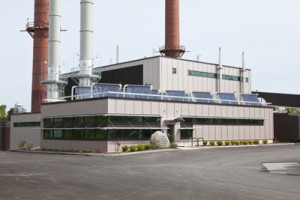 |
Summary Cornell Combined Heat and Power Project View
The project
In 2009, Cornell University released the Climate Action Plan, which sets a goal of reducing campus net greenhouse gas emissions to zero by 2050.
One of the biggest roadblocks to climate neutrality is coal. Historically, Cornell University burned nearly 60,000 metric tons of coal for campus heating. Cornell’s Beyond Coal Initiative was launched in 2010. The key component in the success of this initiative is the new Combined Heat and Power Plant, which achieved a total operational efficiency of supplied heat and power to the campus of nearly 80% for fiscal year 2012.
The results of integrating CHP and eliminating coal are (1) an overall reduction in greenhouse gas emissions of 55,000 metric tons/year; (2) Kyoto Protocol commitments are exceeded, and (3) significant pollutant reductions are achieved by no longer combusting 60,000 metric tons per year of coal. The easier and cheaper way would have been to install conventional natural gas boilers, continue using coal, and buy most of our electricity from the grid. However, Cornell decided that the cost premium over standard practices was the right thing to do and demonstrates a real commitment to promoting sustainability.
Combined heat and power (CHP) is the simultaneous production of electricity and the utilization of “waste” heat for heating requirements. The project is based on two new dual fuel Gas Turbine Generators and natural gas duct fired Heat Recovery Steam Generators for the purpose of supplying the Cornell University (Ithaca, New York) campus with electricity and heating steam. The electrical production displaces electricity previously purchased from the local utility company and the heating steam production displaces steam produced by existing boilers. The project is wholly owned, and operated by Cornell. The project produces 80% of campus electrical power. The project was more complex than installing some new equipment. A dedicated (Cornell owned) 3.2 mile long gas line was constructed to meet natural gas needs. In addition, a major renewal of the electrical substation was needed, increasing the capacity of the substation from 50 MVA to 78 MVA. The Central Energy Plant provides all the centrally produced power and district energy services such as steam and chilled water. The plant serves approximately 150 buildings (13 million sqft) of the central campus and annually produces 215,000,000 killowatt-hrs of electricity, 1,000,000 thousand pounds of steam, and 45,000,000 ton-hrs of chilled water.
PPT Presentation of the Cornell Heat and Power Project View


